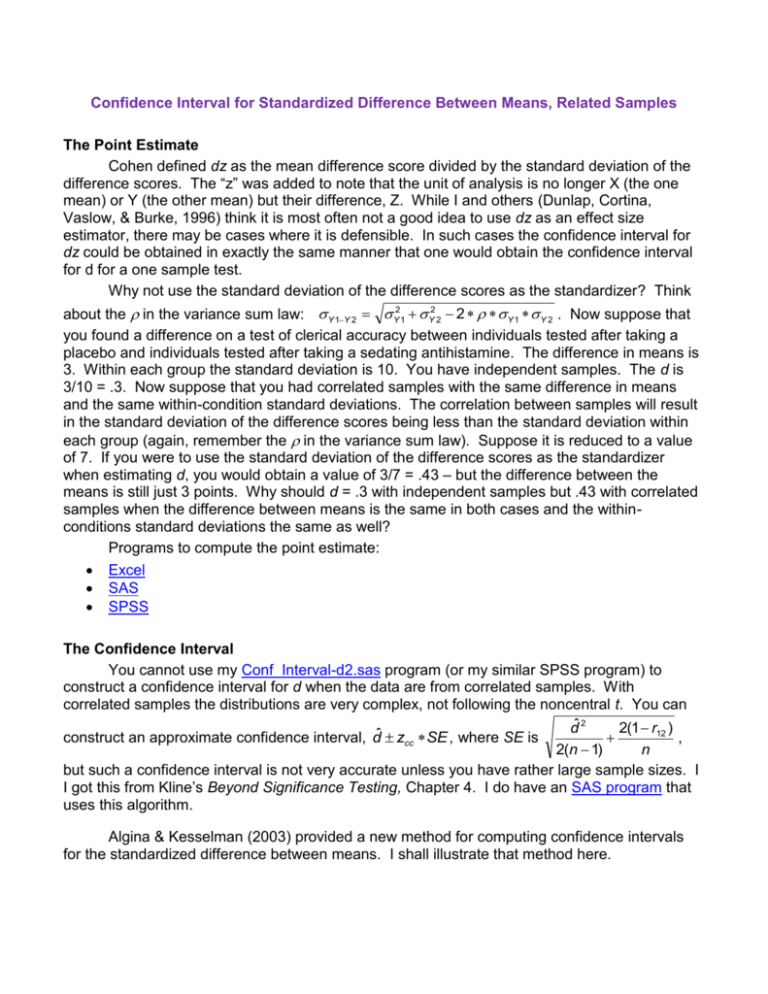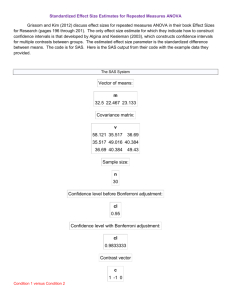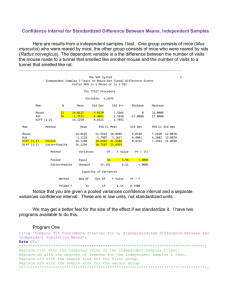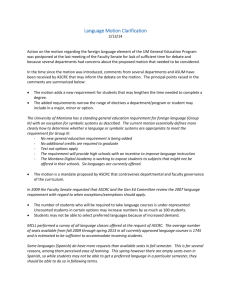
Confidence Interval for Standardized Difference Between Means, Related Samples
The Point Estimate
Cohen defined dz as the mean difference score divided by the standard deviation of the
difference scores. The “z” was added to note that the unit of analysis is no longer X (the one
mean) or Y (the other mean) but their difference, Z. While I and others (Dunlap, Cortina,
Vaslow, & Burke, 1996) think it is most often not a good idea to use dz as an effect size
estimator, there may be cases where it is defensible. In such cases the confidence interval for
dz could be obtained in exactly the same manner that one would obtain the confidence interval
for d for a one sample test.
Why not use the standard deviation of the difference scores as the standardizer? Think
about the in the variance sum law: Y 1Y 2 Y21 Y2 2 2 Y 1 Y 2 . Now suppose that
you found a difference on a test of clerical accuracy between individuals tested after taking a
placebo and individuals tested after taking a sedating antihistamine. The difference in means is
3. Within each group the standard deviation is 10. You have independent samples. The d is
3/10 = .3. Now suppose that you had correlated samples with the same difference in means
and the same within-condition standard deviations. The correlation between samples will result
in the standard deviation of the difference scores being less than the standard deviation within
each group (again, remember the in the variance sum law). Suppose it is reduced to a value
of 7. If you were to use the standard deviation of the difference scores as the standardizer
when estimating d, you would obtain a value of 3/7 = .43 – but the difference between the
means is still just 3 points. Why should d = .3 with independent samples but .43 with correlated
samples when the difference between means is the same in both cases and the withinconditions standard deviations the same as well?
Programs to compute the point estimate:
Excel
SAS
SPSS
The Confidence Interval
You cannot use my Conf_Interval-d2.sas program (or my similar SPSS program) to
construct a confidence interval for d when the data are from correlated samples. With
correlated samples the distributions are very complex, not following the noncentral t. You can
2(1 r12 )
dˆ 2
construct an approximate confidence interval, dˆ zcc SE , where SE is
,
2(n 1)
n
but such a confidence interval is not very accurate unless you have rather large sample sizes. I
I got this from Kline’s Beyond Significance Testing, Chapter 4. I do have an SAS program that
uses this algorithm.
Algina & Kesselman (2003) provided a new method for computing confidence intervals
for the standardized difference between means. I shall illustrate that method here.
2
Run this SAS code:
options pageno=min nodate formdlim='-';
******************************************************************************;
title 'Experiment 2 of Karl''s Dissertation';
title2 'Correlated t-tests, Visits to Mus Tunnel vs Rat Tunnel, Three Nursing Groups
'; run;
data Mus; infile 'C:\D\StatData\tunnel2.dat';
input nurs $ 1-2 L1 3-5 L2 6-8 t1 9-11 t2 12-14 v_mus 15-16 v_rat 17-18;
v_diff=v_mus - v_rat;
proc means mean stddev n skewness kurtosis t prt;
var v_mus V_rat v_diff;
run;
*****************************************************************************;
Proc Corr Cov; var V_Mus V_Rat; run;
Get this output
-------------------------------------------------------------------------------------------------Experiment 2 of Karl's Dissertation
Correlated t-tests, Visits to Mus Tunnel vs Rat Tunnel, Three Nursing Groups
1
The MEANS Procedure
Variable
Mean
Std Dev
N
Skewness
Kurtosis
t Value
Pr > |t|
ƒƒƒƒƒƒƒƒƒƒƒƒƒƒƒƒƒƒƒƒƒƒƒƒƒƒƒƒƒƒƒƒƒƒƒƒƒƒƒƒƒƒƒƒƒƒƒƒƒƒƒƒƒƒƒƒƒƒƒƒƒƒƒƒƒƒƒƒƒƒƒƒƒƒƒƒƒƒƒƒƒƒƒƒƒƒƒƒƒƒƒƒƒƒ
v_mus
22.7291667
10.4428324
48
-0.2582662
-0.3846768
15.08
<.0001
v_rat
13.2916667
10.4656649
48
0.8021143
0.2278957
8.80
<.0001
v_diff
9.4375000
11.6343334
48
-0.0905790
-0.6141338
5.62
<.0001
ƒƒƒƒƒƒƒƒƒƒƒƒƒƒƒƒƒƒƒƒƒƒƒƒƒƒƒƒƒƒƒƒƒƒƒƒƒƒƒƒƒƒƒƒƒƒƒƒƒƒƒƒƒƒƒƒƒƒƒƒƒƒƒƒƒƒƒƒƒƒƒƒƒƒƒƒƒƒƒƒƒƒƒƒƒƒƒƒƒƒƒƒƒƒ
The CORR Procedure
Covariance Matrix, DF = 47
v_mus
v_rat
v_mus
v_rat
109.0527482
41.6125887
41.6125887
109.5301418
Pearson Correlation Coefficients, N = 48
Prob > |r| under H0: Rho=0
v_rat
v_mus
v_rat
0.38075
1.00000
0.0076
To obtain our point estimate of the standardized difference between mean, run this SAS code:
Data D;
M1 = 22.72917 ;
SD1 = 10.44283;
M2 = 13.29167 ;
SD2 = 10.46566;
d = (m1-m2) / SQRT(.5*(sd1*sd1+sd2*sd2)); run;
Proc print; var d; run;
Obtain this result:
Obs
d
3
1
0.90274
Using the approximation method first presented,
SE
.90274 2 2(1 .38075)
0.18567 . A 95% CI is .90274(1.96)(.18567) = [.539, 1.267].
2( 48 1)
48
From James Algina’s webpage, I obtained a simple SAS program for the confidence
interval. Here is it, with values from above.
*This program computes an approximate CI for the effect
size in a within-subjects design with two groups.
m2 and m1 are the means for the two groups
s1 and s2 are the standard deviations for the two groups
n1 and n2 are the sample sizes for the two groups
r is the correlation
prob is the confidence level;
data;
m1=22.7291667 ;
m2=13.2916667 ;
s1=10.4428324 ;
s2=10.4656649 ;
r= 0.38075 ;
n=48
;
prob=.95 ;
v1=s1**2;
v2=s2**2;
s12=s1*s2*r;
se=sqrt((v1+v2-2*s12)/n);
pvar=(v1+v2)/2;
nchat=(m1-m2)/se;
es=(m1-m2)/(sqrt(pvar));
df=n-1;
ncu=TNONCT(nchat,df,(1-prob)/2);
ncl=TNONCT(nchat,df,1-(1-prob)/2);
ul=se*ncu/(sqrt(pvar));
ll=se*ncl/(sqrt(pvar));
output;
proc print;
title1 'll is the lower limit and ul is the upper limit';
title2 'of a confidence interval for the effect size';
var es ll ul ;
run;
quit;
Here is the result:
ll is the lower limit and ul is the upper limit
of a confidence interval for the effect size
Obs
es
ll
ul
1
0.90274
0.53546
1.26275
4
4
The program presented by Algina & Keselman (2003) is available at another of Algina’s
web pages . This program will compute confidence intervals for one or more standardized
contrasts between related means, with or without a Bonferroni correction, and with or without
pooling the variances across all groups. Here is code, modified to compare the two related
means from above.
* This program is used with within-subjects designs. It computes
confidence intervals for effect size estimates. To use the program one
inputs at the top of the program:
m--a vector of means
v--a covariance matrix in lower diagonal form, with periods for
the upper elements
n--the sample size
prob--the confidence level prior to the Bonferroni adjustment
adjust--the number of contrats is a Bonferroni adjustment to the
confidence level is requested. Otherwise adjust is set
equal to 1
Bird--a switch that uses the variances of all variables to calculate
the denominator of the effect size as suggested by K. Bird
(Bird=1). Our suggestion is to use the variance of those
variables involved in the contrast to calculate the denominator
of the effect size (Bird=0)
In addition one inputs at the bottom of the program:
c--a vector of contrast weights
multiple contrasts can be entered. After each, type the code
run ci;
proc iml;
m={ 22.72917 13.29167};
v={109.0527482 . ,
41.6125887 109.5301418};
do ii = 1 to nrow(v)-1;
do jj = ii+1 to nrow(v);
v[ii,jj]=v[jj,ii];
end;
end;
n=48
;
Bird=1;
df=n-1;
cl=.95;
adjust=1;
prob=cl;
print 'Vector of means:';
print m;
print 'Covariance matrix:';
print v;
print 'Sample size:';
print n;
print 'Confidence level before Bonferroni adjustment:';
print cl;
cl=1-(1-prob)/adjust;
print 'Confidence level with Bonferroni adjustment:';
print cl;
start CI;
pvar=0;
5
count=0;
if bird=1 then do;
do mm=1 to nrow(v);
if c[1,mm]^=0 then do;
pvar=pvar+v[mm,mm];
count=count+1;
end;
end;
end;
if bird=0 then do;
do mm=1 to nrow(v);
pvar=pvar+v[mm,mm];
count=count+1;
end;
end;
pvar=pvar/count;
es=m*c`/(sqrt(pvar));
se=sqrt(c*v*c`/n);
nchat=m*c`/se;
ncu=TNONCT(nchat,df,(1-prob)/(2*adjust));
ncl=TNONCT(nchat,df,1-(1-prob)/(2*adjust));
ll=se*ncl/(sqrt(pvar));
ul=se*ncu/(sqrt(pvar));
print 'Contrast vector';
print c;
print 'Effect size:';
print es;
Print 'Estimated noncentrality parameter';
print nchat;
Print 'll is the lower limit of the CI and ul is the upper limit';
print ll ul;
finish;
c={1 -1};
run ci;
quit;
Here is the output:
ll is the lower limit and ul is the upper limit
of a confidence interval for the effect size
Vector of means:
m
22.72917
13.29167
Covariance matrix:
v
109.05275 41.612589
41.612589 109.53014
6
Sample size:
n
48
Confidence level before Bonferroni adjustment:
cl
0.95
Confidence level with Bonferroni adjustment:
cl
0.95
Contrast vector
c
1
-1
Effect size:
-------------------------------------------------------------------------------------------------ll is the lower limit and ul is the upper limit
of a confidence interval for the effect size
es
0.9027425
Estimated noncentrality parameter
nchat
5.619997
ll is the lower limit of the CI and ul is the upper limit
ll
ul
0.5354583 1.2627535
Notice that this produces the same CI produced by the shorter program.
Recommended additional reading:
7
Algina, J., & Keselman, H. J. (2003). Approximate confidence intervals for effect sizes.
Educational and Psychological Measurement, 63, 537-553. DOI:
10.1177/0013164403256358
Dunlap, W. P., Cortina, J. M., Vaslow, J. B., & Burke, M. J. (1996). Meta-analysis of
experiments with matched groups or repeated measures designs. Psychological
Methods, 1, 170-177.
Grissom, R. J., & Kim, J. J. (2005). Effect sizes for research: A broad practical
approach. Mahwah, NJ: Erlbaum. – especially pages 67 and 68
Glass, G. V., & Hopkins, K. D. Statistical methods in education and psychology (2nd ed.),
Prentice-Hall 1984. Section 12.12: Testing the hypothesis of equal means with paired
observations, pages 240-243. Construction of the CI is shown on page 241, with a
numerical example on pages 242-243.
Kline, R. B. (2004). Beyond significance testing: Reforming data analysis methods in
behavioral research. Washington, DC: American Psychological Association. 325 pp.
{First edition. There is a second edition out now.}
Back to Wuensch’s Stats Lessons Page
Copyright 2015, Karl L. Wuensch - All rights reserved.
Fair Use of This Document









